“If…anchorage…Duct Tape is on the rocks…,” was pretty much all I picked out before the VHF went crazy with static and people stepping on each other. We turned up the radio and started sweeping the far shoreline with binoculars. “Don’t know if anyone can help…looks pretty bad…please, there’s a boat on the rocks outside the La Cruz marina.” I handed off the binoculars to Steve and Eli, because I see for crap wasn’t coming up with anything. “There! See…look where all the dinghies are swarming around and…shit…,” Steve said. I positioned myself on the bowsprit and looked where he was pointing (as if 10 or 15 feet closer was going to make much difference) and finally made out the mast of a small sailboat, rocking violently back and forth in a way that looked wrong. Really wrong.
“Aw crap,” I said, looking down at our perpetually sinking dinghy and then back out across the long stretch of water between where we’d anchored and the rest of the anchorage. In La Cruz, we’ve anchored close to the breakwater, in the middle of the pack, and on the fringe of what you’d call the anchorage proper. We keep looking for this anchorage’s sweet spot, but basically have come to the conclusion that the La Cruz anchorage isn’t happy unless it gets to knock you around a lot of the time. Turns out it’s waaay smoother halfway to Bucerias, plus you have plenty of room to put out a stern anchor, which keeps your bow pointing into the swell, instead of taking it on the beam half of the time. But you’re nearly a mile away from the marina, which is a long way to go in a dinghy that won’t stay inflated.
“Should we,” Steve starts to say. “Do you think we should help?” finishes Eli. We all look down at our pathetic dinghy. And back to the boat on the rocks. The VHF keeps squawking static and panic. “Yeah,” I say, “I think we’d better. Eli, go grab our life jackets out of the kayak. I’m gonna put something better than a bathing suit on.” Down below, all I’m coming up with is a crappy pair of denim shorts (two sizes, too big), no belt, and a knife with no clip on it. Are you freaking kidding me? The conversation I had with myself, trying to tie a rigging knife to my shorts with a piece of broken shoelace, was colorful and interesting and completely unprintable. Use your imagination.
I holler out to Steve, “Grab the DC bag. And the hacksaw.” “Already on it,” he shouts back, because he’s awesome that way, “I’m going to pump up the dinghy.” By the time I’m topside again, Steve has the semi-inflatable ready to go and asks if we should bring the 300’ of useless hockled anchor line we don’t need anymore. In light of the current emergency, that hockled pile of crap looks moderately useful again, so in it goes. Meanwhile, Eli’s gone and rounded up the backpack, our handheld VHF radio, his camera, and everything else that I’d forgotten. We leave the dog to watch the boat and haul ass, fast as we can. But carefully. Trying not to put undue pressure on the “flatable” parts of the dinghy. Luckily, Eli can plug up the worst of the air leaks with his hand. It was a wet ride.
We arrived on scene to find chaos and desperation. Bunch of skiffs zooming around full of people who had labored heroically to help but ultimately ran out of options. We’re talking above and beyond. They tried pushing her off and pulling her off, but the truth is, even pushing all at once, none of us cruisers have an outboard strong enough to pull a sailboat off those rocks. Even a little one, like Duct Tape. She’s wedged fast, between enormous jagged rocks and both the tide and the wind are against her.
Steve noses the dinghy alongside and I yell up to the guy on the bow, “Do you need help?” He looks at me and says, “I just…I don’t…” A wave rolls through and pounds the sailboat into the rocks with a sickening thud. I try again, “Hi, I used to be in the Coast Guard. Can I come on your boat and help you?” He nods, so I grab hold of the lifelines to pull myself aboard and get stuck for a minute when my lifejacket gets hung up on the top lifeline. Smooooth. Yep. Way to look professional. I manage to clamber over the side without falling in the water and take the Damage Control kit that Eli hands up. “I’m Tamiko,” I say, “Are you taking on water?” “I don’t know,” he says. “Are you OK up here?” I ask, “Can I go below and make sure you’re not taking on water?” “Yes,” he says, “and maybe help my wife.”
I crouch down and scoot under the tarp that drapes across the boom and is fastened tight against the lifelines. Dragging the yellow duffle behind me, I emerge into the cockpit and meet a very surprised lady, with short bobbed hair. “Hi,” I say, “I’m Tamiko and I’m here to help you guys out. I need to check your bilges to make sure you’re not taking on water, all right? Do you have a Damage Control kit on board?”
She looks a little shell-shocked, but is holding her own, which is better 75% of the people I rescued, back in the day. “Well,” she says, “We’ve got a bunch of tools and fiberglass…” “Plugs and wedges?” I ask. “You know where they are?” She nods on both counts and then says, “I guess we have everything except the book.” “That’s all right,” I say, “Sounds like you’re pretty squared away.”
She mans the tiller and the radio, while I tumble down below to discover that everything that wasn’t literally nailed down is now sliding around on the cabin sole. An incoming swell slams us violently back and forth. The noise is just incredible. Wind howls through the anchorage, pinning the little boat down and with each crashing wave, the hull groans and smashes into the rocks. People everywhere yelling, the engine rumbling on, and that darn tarp flapping so hard it’s like knives in your ear. I grab a handhold and start chucking cabbages and other foodstuffs forward, into the v-berth, using the floor of their head to corral most everything else. Everything except the little digital camera I snagged on the fourth or fifth try, and a headlamp. I shoved the camera into the second drawer I found, which happened to be the first one with room enough not to crush the wee thing, and hung on to the headlamp for future reference.
Duct Tape has sturdy rubberized non-skid on the floor and it takes me a second or two to figure out that there’s really not any kind of bilge access to be had from the floor. I pop my head back up and ask, “What’s your name and where’s the closest access to the bilge?” “Phyllis,” she says, pointing down at the companionway step, “Lift that up and then the bins! Get those out of the way and then you can see!” It’s like unpacking Russian nesting dolls, but I finally get down to the bottom and put that headlamp to good use. There’s just a sliver of bilge visible, but no water coming in to speak of and I am feeling cautiously optimistic at this point.
“All right!” I holler up to Phyllis, “No water. Looks good. How are you doing? Do you need me to do anything right now?” She gives me a ghost of a grin and says, “Hanging in…I don’t know.” I ask her if there’s any way to get a look at the shaft and she says, “I don’t know…I’m so sorry…my husband Sig would know.” I give her shoulder a squeeze, “Hey, you’re doing great. I’m gonna go forward and talk to your husband, ok? You’re all right.”
I quasimodo my way under the tarp and back up to the bow, where Sig has been busy hooking Duct Tape to the back of two pangas with big, powerful outboards. They push their engines to the max, but we aren’t going anywhere, except back and forth between these stupid jagged rocks. I ask about the shaft and Sig says everything that can be seen is what you’d see looking down that little peephole I already peeped through. “If there’s any water coming in, you’ll see it first, right there.” “Well that’s good,” I say, “Because it looks pretty dry to me. How are you doing out here?” He’s kneeling on the bow and looks up at me kind of funny, all of a sudden. His voice catches for a second. “You know…,” he says. “I don’t…I’m not really a sailor. I don’t know what to do.”
I give his shoulder a quick squeeze and say, “Sig, man…you guys are doing just fine. Tons better than most people.” He gives me a look that says maybe he thinks I’m fibbing. But I’m not. I’ve seen plenty of people in easier situations just freeze and give up. Everything about this whole situation is horrible and scary, but Duct Tape is fighting back with everything they’ve got. “Between everybody out here, we’re gonna figure this out,” I say.
One of the pangas gets a line caught in his prop and is out of comission until they can get it untangled. Steve and Eli come zooming up and Steve yells to Sig, “Do you have a kedge anchor?” Sig hollers back that he doesn’t know what that is. “We need to connect an anchor line to the top of your mast, like to a halyard,“ Steve shouts, “Then we’ll take the anchor in the dinghy and dump it in the water, way over there, ok?” Sig nods and Steve continues on, “When you guys winch the anchor line tight, it’ll drag the top of your mast down and lift the keel up sideways, then maybe they can pull you off.” Sig, Eli, and Steve work on rigging that up and I duck back under the tarp to touch bases with Phyllis and let her know what’s going on. Steve and Eli take the anchor out a ways, then dump it over the side and set it.
I’m back at the bow, where we start to winch the boat perpendicular, but it’s slow going. “Do you have a longer winch handle?” Steve shouts and Sig sends me back to Phyllis for it. I make it halfway down the tarp tunnel, getting whacked on the head every time the thing flaps, and there she is, stretched out far as she can reach, handing off the new winch handle. She rolls her eyes at the ridiculous tarp and says with a wry grin, “Not so good for this, huh?” I am really starting to like this woman.
The new winch handle works so well that we suddenly have to pay attention to non-winching things, like not falling overboard. And then, all of a sudden, we’re right side up and going like all the hounds of hell are nipping at our heels (about 15 knots), heading straight into the side of another anchored boat. In nanoseconds we go from still screwed to jubilation to ohcrapohcrapohcrap. Sig said something that might not be printable and I was kind of agreeing with him, at that point. We got into a fending stance and prepared for the worst case. “You know Sig, I don’t think we’re gonna t-bone this guy. I think the tow line is gonna come tight in a second and pull us over. If anything, we’ll touch more side-to-side. What do you think?” He gave me one of those in-the-trenches looks, which is right next door to gallows humor, and said, “That would be better.” Then the tow line came taut and we missed that pretty red boat, with all of a couple inches to spare.
From the dinghy’s perspective, Steve and Eli could see that the reason we were actively crashing into the side of the red boat is that the panga, which was towing us so enthusiastically a moment before, had wrapped the tow line in their propeller. The poor pangeros were frantically trying to clear the mess, acutely aware that we were going to plow into the side of another boat in a matter of seconds. Once they cleared the prop, they went back to towing us pangero-style, otherwise known as the near-light-speed approach to towing. I highly recommend it. Keeps the adrenaline flowing nicely.
Steve and Eli call out that we’ve got a line in the water and then look back to see the kedge anchor skipping across the top of the water and heading straight for the back of the panga that was out of commission. The guys in that panga are grabbing for the line, trying to keep it off their antenna pole and Steve and Eli are going fast as they can, waving their arms and screaming, “Get down! Down! Abajo!” But the panga guys don’t realize what’s at the other end of that line until just before the anchor hits the side of their boat, richochets off the outboard motor, launches skyward and keeps right on going. Holy crap–I’m glad nobody got beaned in the head.
In another minute or so, Steve and Eli catch up to the rouge anchor and unshackle it before it kills anyone. Then they’re going back and forth between Duct Tape and the panga that’s towing us, relaying messages in Spanglish, with a lot of gesturing thrown in for good measure. I try and haul in the line we were warned about and find it tight against the hull with no slack whatsoever. “The engine just stopped.” Phyllis says, all the trench humor gone out of her voice. “Is it overheated?” I ask. “No,” she says, “Turn the key off,” I say, “I think we got a line caught in the prop.” Half a second later, Sig says tiredly, “Yeah, definitely got a line in the prop.” Murphy’s Law works overtime on the water.
Phyllis calmly steers us through the channel while the panga tows us in to the La Cruz marina. We get on the radio and try to get a slip assignment, but aren’t really getting anywhere. As we pass the breakwater, there’s a guy with a clipboard, jumping up and down and hollering out the slip number, but in the end it came down to whatever we could pull off. Sig and I were trying to rig fenders and dock lines, without knowing which side we’d be tying off to. The panga towing us was having a heck of a time keeping the tow line out of their own prop and there was a lady on the dock yelling for us to come in behind her. In fact, tons of people on the dock yelling a bunch of stuff we couldn’t understand. It was mayhem. Making split-second decisions in complete chaos is what makes emergencies so entertaining, right?
Finally, Sig decided we should go for the closest “safe harbor” slip we could reach. For a minute, things looked pretty sketchy–looked like we kind of lost our window of opportunity. Then, the second panga threw a line to the first panga, and pulled them in a direction that would move us over into the nearest big slip. And just like that, we were there, and people were grabbing lines and it was over and Duct Tape was safe.
At which point everybody cried a little and hugged and got the adrenaline shakes. Hats off to everyone who helped on the water, over the radio, and all those in the anchorage who couldn’t physically help, but were sending their prayers and good vibes out. To the guy on the radio who did not help and was yelling at everybody for using “his” hailing channel—+500 points for pure and utter suckage, dude. Nobody made you Lord of the Airwaves and in this emergency situation; it was better for people to use that channel to communicate, even if it inconvenienced you for an hour or so.
Duct Tape did not drag anchor, which kind of freaked me out, when I thought about it later. She was set up pretty much exactly the way we used to be: 50’ of chain and then 3-strand after that. Only difference is that her stuff was in much better shape than what we’d been using. Sharp rocks shredded the anchor line about 5’ up from where the chain stopped. It didn’t take very long, either. I don’t think they’d been anchored in that spot for more than a day or so. We had problems with hockles coming down the coast, from Turtle Bay to all points south, and had been trying to decide if we were going to buy new 3-strand or a couple hundred feet of chain. A few weeks ago, we ended up getting 200’ of 3/8” chain from Zaragoza’s in Puerto Vallarta, for a little bit less than if we could’ve got it from Defender and for a lot less than the other US suppliers that we checked out.
SUPER glad we went with chain.
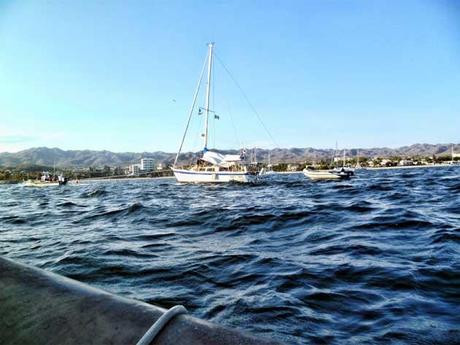
Taken after Steve and Eli neutralized the flying anchor. You can just see the halyard trailing aft. It ended up in Duct Tape’s skiff a minute later.
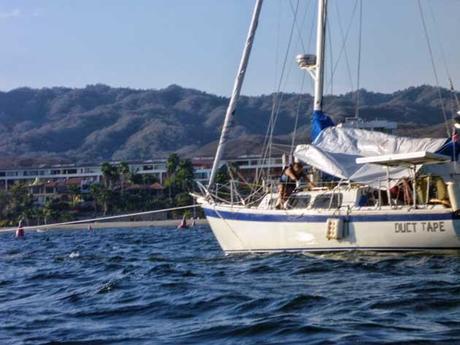
Going back through the tarp tunnel of doom ;-) When we were still on the rocks, those side-mounted solar panels kept threatening to take huge chunks out of our dinghy or scalp Steve and Eli.
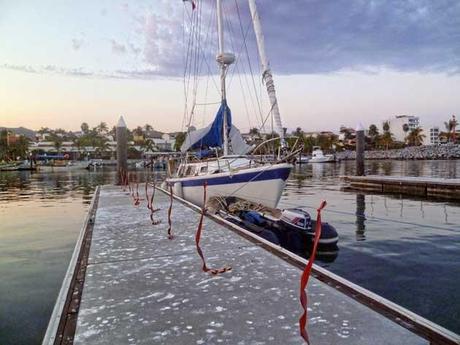
Duct Tape on the pelican crap speckled dock. Cal 29′s are crazy strong boats.
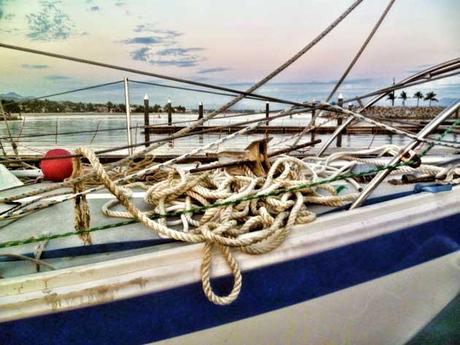
The aftermath. That ragged end of 3-strand is what got shredded on the rocks. I guess it shouldn’t surprise me that the rocks are sharp enough to do this in a short period of time–every time Steve goes surfing out here, he comes back with his hands and feet all cut up from those same rocks.

We left our crappy dinghy tied up next to Duct Tape and went to get some sodas!

They hung out a thank you banner, in duct tape, naturally! She’s listing a little to starboard, but not taking on water…she always leans a bit in that direction.

Sig and Phyllis did an awesome job of keeping cool under fire. You guys rock!!!
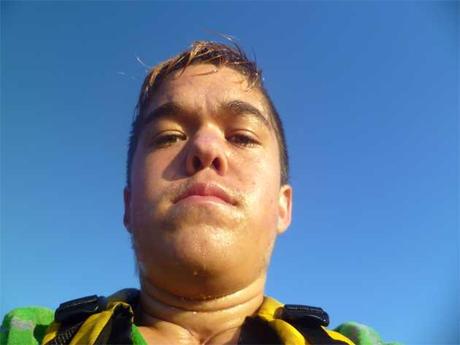
Like I said, it was a wet ride and the rescue effort wasn’t much drier.
